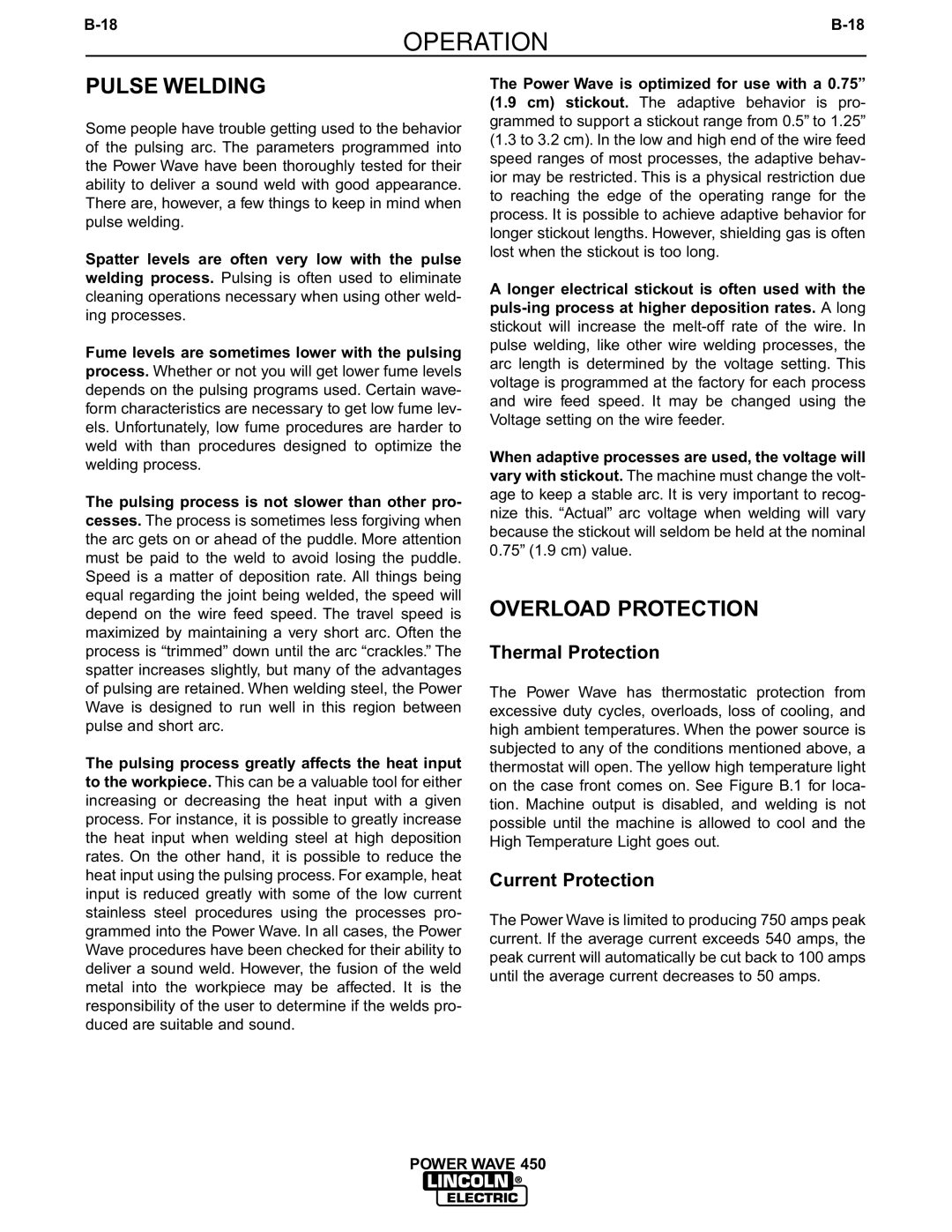
OPERATION
PULSE WELDING
Some people have trouble getting used to the behavior of the pulsing arc. The parameters programmed into the Power Wave have been thoroughly tested for their ability to deliver a sound weld with good appearance. There are, however, a few things to keep in mind when pulse welding.
Spatter levels are often very low with the pulse welding process. Pulsing is often used to eliminate cleaning operations necessary when using other weld- ing processes.
Fume levels are sometimes lower with the pulsing process. Whether or not you will get lower fume levels depends on the pulsing programs used. Certain wave- form characteristics are necessary to get low fume lev- els. Unfortunately, low fume procedures are harder to weld with than procedures designed to optimize the welding process.
The pulsing process is not slower than other pro- cesses. The process is sometimes less forgiving when the arc gets on or ahead of the puddle. More attention must be paid to the weld to avoid losing the puddle. Speed is a matter of deposition rate. All things being equal regarding the joint being welded, the speed will depend on the wire feed speed. The travel speed is maximized by maintaining a very short arc. Often the process is “trimmed” down until the arc “crackles.” The spatter increases slightly, but many of the advantages of pulsing are retained. When welding steel, the Power Wave is designed to run well in this region between pulse and short arc.
The pulsing process greatly affects the heat input to the workpiece. This can be a valuable tool for either increasing or decreasing the heat input with a given process. For instance, it is possible to greatly increase the heat input when welding steel at high deposition rates. On the other hand, it is possible to reduce the heat input using the pulsing process. For example, heat input is reduced greatly with some of the low current stainless steel procedures using the processes pro- grammed into the Power Wave. In all cases, the Power Wave procedures have been checked for their ability to deliver a sound weld. However, the fusion of the weld metal into the workpiece may be affected. It is the responsibility of the user to determine if the welds pro- duced are suitable and sound.
The Power Wave is optimized for use with a 0.75” (1.9 cm) stickout. The adaptive behavior is pro- grammed to support a stickout range from 0.5” to 1.25” (1.3 to 3.2 cm). In the low and high end of the wire feed speed ranges of most processes, the adaptive behav- ior may be restricted. This is a physical restriction due to reaching the edge of the operating range for the process. It is possible to achieve adaptive behavior for longer stickout lengths. However, shielding gas is often lost when the stickout is too long.
A longer electrical stickout is often used with the
When adaptive processes are used, the voltage will vary with stickout. The machine must change the volt- age to keep a stable arc. It is very important to recog- nize this. “Actual” arc voltage when welding will vary because the stickout will seldom be held at the nominal 0.75” (1.9 cm) value.
OVERLOAD PROTECTION
Thermal Protection
The Power Wave has thermostatic protection from excessive duty cycles, overloads, loss of cooling, and high ambient temperatures. When the power source is subjected to any of the conditions mentioned above, a thermostat will open. The yellow high temperature light on the case front comes on. See Figure B.1 for loca- tion. Machine output is disabled, and welding is not possible until the machine is allowed to cool and the High Temperature Light goes out.
Current Protection
The Power Wave is limited to producing 750 amps peak current. If the average current exceeds 540 amps, the peak current will automatically be cut back to 100 amps until the average current decreases to 50 amps.
